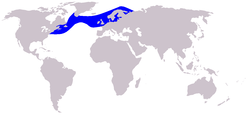Atlantic White-sided Dolphin
|
|
| Atlantic White-sided Dolphin Conservation status: Lower risk | ||||||||||||||||||
|---|---|---|---|---|---|---|---|---|---|---|---|---|---|---|---|---|---|---|
| Scientific classification | ||||||||||||||||||
| ||||||||||||||||||
| Binomial name | ||||||||||||||||||
| Lagenorhynchus acutus (Gray, 1828) | ||||||||||||||||||
 Atlantic White-sided Dolphin range |
The Atlantic White-sided Dolphin (Lagenorhynchus acutus) is a distinctively coloured dolphin found in the cool to temperature waters of the North Atlantic Ocean.
| Contents |
Taxonomy
The Atlantic White-sided Dolphin was named by Gray in 1828. The specific name acutus comes from the Latin for pointed and refers to the dorsal fin. It is one of six oceanic dolphins in the Lagenorhynchus genus.
Physical description
The dolphin is slightly larger than most other oceanic dolphins. It is just over a metre in length at birth, growing to about 2.8m (males) and 2.5m (females) at maturity. It weighs between 200kg and 230kg once fully-grown. Females reach sexual maturity at between 6 and 12 years, and males between 7 and 11 years. The gestation period is 11 months and lactation lasts for about a year and a half - both typical figures for dolphins. Individuals are known to live for upto 22 years (males) and 27 years (females).
The key distinguishing, and attractive, feature is the white to pale yellow patch found behind the dorsal fin of the dolphin on each side. This variation in colour to the Atlantic White-sided Dolphin is unique amongst the mixtures of white, greys and blues of other pelagic cetaceans. The rest of the body's coloration is well demarced - The chin, throat and belly are white. The flippers, dorsal fin and back are dark grey to black with the exception of the yellow patch. There is a further white patch below the dorsal fin, lying above a light grey stripe that runs from the beak, above the eye and down to the tail stock.
Dolphin group sizes vary by location. With groups averaging 60 in number close to the Newfoundland shores, but rather smaller east of Iceland.
From the analysis of the stomach contents of stranded animals, fish such as herring and mackerel and squid appear to form the species main diet. The Atlantic White-sided Dolphin is fairly acrobatic and keen to interact with boats, however it is not as wildly gregarious as the White-beaked and Common Dolphins.
Population and distribution
The species is endemic to the North Atlantic Ocean. Areas of particularly high population density include the shores of Newfoundland and Cape Cod, the triangular area of sea between the United Kingdom, Iceland and Greenland and the North Sea. The total population is believed to be 200-300,000 individuals.
Human interaction
Historically Atlantic White-sided Dolphins were killed in drives conducted from Norway and Newfoundland. These have disappeared in recent years, although they still occur to a lesser extent from the Faroe Islands, killing around 1000 animals a year. It is not known what the long term effect of this will be on this neighbourhood of the ocean, and this has aroused the concern of conservationists, however the wider scale survival of the species is not believed to be threatened.
References
- Atlantic White-sided Dolphin by Frank Cipriano, Encyclopedia of Marine Mammals pp49-51 ISBN 0125513402
- National Audubon Society: Guide to Marine Mammals of the World ISBN 0375411410
- Encyclopedia of Marine Mammals ISBN 0125513402de:Wei▀seitendelfin
